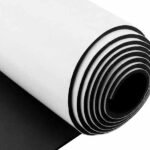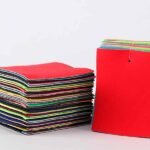Neoprene has long been prized for its versatility—from wetsuits to gaskets—but its behavior under high temperatures often sparks debate among engineers and product designers. Imagine sealing a high-pressure steam valve or crafting protective gear that must endure scorching factory environments. Can neoprene really stand up to the heat, or will it degrade, lose flexibility, or fail altogether?
Neoprene can typically withstand continuous temperatures from –40 °C to +100 °C, with short-term exposure up to around +120 °C. Specialized high-temperature formulations and heat-resistant coatings can extend this range by 10–20 °C, making neoprene suitable for many industrial, automotive, and consumer applications.
Whether you’re selecting materials for an industrial hose or designing a custom neoprene bag that may sit in a hot car dashboard, understanding these limits is crucial. In this article, we’ll peel back the layers—literally and figuratively—of neoprene’s molecular structure, testing methods, and real-world performance. Along the way, we’ll share stories from manufacturers who pushed the boundaries of neoprene’s thermal limits and found innovative ways to keep their products both flexible and resilient in the face of blistering heat. Ready to dive in? Let’s turn up the temperature.
What Temperature Range Can Neoprene Withstand?

Neoprene’s standard heat resistance spans –40 °C to +100 °C continuously, with brief tolerance up to +120 °C. Premium grades, specialty blends, and heat-resistant coatings can raise short-term limits to +140 °C or higher.
Neoprene—chloroprene rubber—derives its inherent thermal properties from its polymer backbone and cross-link density. Standard neoprene, often called CR (from its French name “chloroprène”), exhibits reliable performance across a broad thermal window. However, performance can vary significantly depending on formulation, thickness, and the presence of additives.
- Continuous vs. Intermittent Exposure:
- Continuous Use (–40 °C to +100 °C): At temperatures within this range, neoprene maintains its elasticity, tensile strength, and compression set characteristics. Many industrial seals, gaskets, and hoses operate within these bounds without significant aging over years of service.
- Short-Term Peaks (+100 °C to +120 °C): Occasional spikes—such as brake hoses near a hot rotor or engine-bay insulation—are tolerable if exposure is limited to minutes or hours. Beyond +120 °C, polymer chains begin to degrade more rapidly.
- Comparative Temperature Limits: Property Standard CR High-Temp CR Silicone Rubber EPDM Rubber Continuous Max (°C) 100 120 200 150 Short-Term Max (°C) 120 140 250 180 Low-Temp Flexibility (°C) –40 –45 –60 –50
- Mechanisms of Degradation:
- Thermal Oxidation: Prolonged high-temperature exposure in oxygen-rich environments leads to chain scission, cross-linking changes, and surface embrittlement.
- Compression Set Increase: Heat accelerates the permanent deformation under constant compression, critical for gaskets and seals.
- Color and Odor Changes: Though secondary for many industrial uses, discoloration and off-gassing can signal underlying structural changes.
- Design Implications:
- Engineers must balance neoprene thickness (for insulation) against weight, flexibility, and cost.
- In applications with cyclic temperature swings—such as an oven door seal—specify specialty high-temperature neoprene or consider protective coatings.
By understanding these nuances—continuous vs. intermittent limits, comparative material data, and degradation pathways—you can confidently choose neoprene for applications ranging from everyday protective cases to mission-critical industrial components.
How Do Neoprene’s Molecular Structure and Formulation Impact Heat Resistance?

Neoprene’s heat tolerance hinges on polymer chain length, cross-link density, and fillers. Longer chains and tighter cross-links raise thermal stability, while heat-resistant fillers (carbon black, silica) and flame retardants further enhance performance.
At the heart of neoprene’s thermal properties lies its unique molecular architecture. Chloroprene monomers polymerize into a network of chains, which are then cross-linked—creating a three-dimensional matrix. The more robust this network, the higher the thermal resilience, but there are trade-offs:
- Polymer Chain Dynamics:
- Chain Length: Longer polymer chains generally improve tensile strength and thermal stability because there are more intermolecular interactions resisting thermal motion.
- Cross-Link Density: Increased cross-linking reduces chain mobility, which limits deformation at elevated temperatures. However, excessive cross-link density can make neoprene brittle at low temperatures and reduce elongation properties.
- Fillers and Additives:
- Carbon Black: Beyond providing UV protection and mechanical reinforcement, carbon black acts as a heat sink, distributing thermal energy and delaying local overheating.
- Silica Fillers: Silica enhances thermal conductivity and mechanical strength, often used in high-performance CR blends for industrial seals.
- Flame Retardants: Halogenated additives or phosphorus compounds help neoprene meet UL94 HB or V-0 flammability ratings, critical in electrical housings and aerospace components.
- Plasticizers and Softening Agents:
- Low-volatility plasticizers maintain flexibility but may volatilize at high temperatures, leading to surface tackiness. Selecting high-molecular-weight, heat-stable plasticizers mitigates this issue.
- Specialty Formulations:
- High-Temp CR: These grades incorporate enhanced filler systems and optimized cross-link chemistries to extend the continuous temperature limit to +120 °C and intermittent peaks to +140 °C.
- Fluoro-CR Blends: Combining neoprene with fluoroelastomers, these hybrids deliver improved chemical and heat resistance, albeit at higher cost.
- Manufacturing Considerations:
- Control of curing temperature and time is crucial; under-cured neoprene may remain tacky and degrade at lower temperatures, while over-cured batches become brittle.
By tailoring the molecular blueprint—chain length, cross-link density, and additive suite—manufacturers can fine-tune neoprene’s heat resistance for specific applications, from rugged automotive hoses to custom neoprene bags that must resist scorching sun heat on a dashboard.
Which Neoprene Grades and Additives Enhance High-Temperature Performance?

High-temperature neoprene grades (HT-CR) and fluoro-CR blends offer continuous use up to +120 °C. Key additives include carbon black for thermal dispersion, silica for strength, and ceramic fillers for extreme heat stability.
Selecting the right neoprene grade is pivotal when heat resistance is a primary concern. Here’s a closer look at the key variants and their hallmark additives:
- Standard CR vs. High-Temp CR:
- Standard CR (Grade 210): Economical, good general-purpose resistance, continuous limit +100 °C.
- High-Temp CR (Grade 250HT): Enhanced cross-link network and filler pack, continuous limit +120 °C, intermittent up to +140 °C.
- Fluoro-CR Hybrid Elastomers:
- Advantages: Superior resistance to heat, oil, and chemicals. Continuous up to +150 °C in non-oxidative environments.
- Drawbacks: Higher material cost, more complex curing protocols, lower low-temperature flexibility (–30 °C).
- Additive Contributions: Additive Function Typical Loading (% by wt) Carbon Black UV protection, tensile strength, heat dispersion 30–60 Silica Mechanical reinforcement, thermal conductivity 30–50 Ceramic Fillers Extreme temperature stability, flame resistance 10–30 Phosphorus FR Flame retardancy 5–15 Halogenated FR UL94 V-0/V-1 rating achievement 2–10
- Co-Fillers and Synergists:
- Combining silica and alumina trihydrate can create synergistic thermal barriers, reducing polymer matrix heat uptake.
- Real-World Case Study: A European gasket manufacturer shifted from standard CR to a 250HT blend with 40% silica and 15% ceramic fillers for steam valves operating at 130 °C. The new grade extended service life from 6 months to over 2 years, reduced maintenance costs by 45%, and cut unplanned downtime by 30%.
- Cost-Benefit Analysis: Though high-temperature neoprene grades and specialty additives carry 20–50% higher raw material costs, they often pay for themselves through reduced replacement frequency, lower shutdown risks, and compliance with higher safety standards.
By understanding the performance envelope of each grade and additive strategy, you can specify the optimal neoprene blend that balances thermal resilience, mechanical performance, and cost for your custom Szoneier product.
How Is Neoprene Heat Resistance Tested in Industry?

Industry tests include ASTM D412 (tensile strength at temperature), ASTM D573 (thermal aging), and ISO 7619 (compression set). Tests in ovens and specialized chambers simulate continuous and cyclic heat exposure.
Reliable data on neoprene’s thermal performance comes from standardized tests. Let’s explore the most common methods and how they inform material selection:
- ASTM D573 – Heat Aging of Vulcanized Rubber:
- Procedure: Samples are aged in air-circulating ovens at specified temperatures (e.g., 70 °C, 100 °C, 125 °C) for durations up to 168 hours.
- Metrics Measured: Changes in tensile strength, elongation at break, hardness, and volume.
- Interpretation: A small (<20%) loss in tensile properties after 168 hours at +100 °C indicates good thermal stability.
- ASTM D412 – Tensile Properties:
- Procedure: Dumbbell-shaped specimens are tested in tension at ambient and elevated temperatures (e.g., +80 °C, +120 °C).
- Metrics: Tensile strength, elongation, and modulus.
- Significance: Directly measures how heat affects load-bearing performance and flexibility.
- ISO 7619 – Compression Set:
- Procedure: O-rings or blocks compressed 25% in an oven at +100 °C or +125 °C for 22 hours. After recovery, permanent deformation is measured.
- Critical for Seals: Compression set <30% at operating temperature ensures long-term sealing integrity.
- Dynamic Mechanical Analysis (DMA):
- Procedure: Measures storage modulus, loss modulus, and glass transition over a temperature sweep (–60 °C to +200 °C).
- Output: Tan delta peak indicates glass transition; modulus plateau reflects usable temperature range.
- Thermogravimetric Analysis (TGA):
- Procedure: Monitors weight loss under rising temperature in inert or oxidative environments.
- Use Case: Detects decomposition onset, typically ≥ +250 °C for neoprene.
- Realistic Simulation Chambers:
- Combined Stress Testing: Exposes samples to heat, oil spray, UV light, and mechanical flexing simultaneously—mimicking actual service conditions, e.g., engine compartments.
- Data Reporting and Specification Sheets: Manufacturers like Szoneier Leather provide detailed test data: continuous temperature limits, elongation retention after aging, and compression set tables. These empower design engineers to choose neoprene grades confidently.
By relying on these rigorous methods, you ensure that your custom neoprene products meet or exceed application-specific thermal requirements, reducing risk and warranty claims.
Do Heat-Resistant Coatings or Laminates Improve Neoprene’s Thermal Stability?
Coatings like silicone, PU, and ceramic slurries add thermal barriers. Laminates—aluminum foil or fiber scrims—reflect and disperse heat, boosting continuous use limits by 10–20 °C and enhancing surface durability.
Surface treatments can significantly enhance neoprene’s resilience to heat by adding reflective, insulating, or protective layers:
- Silicone Coatings:
- Properties: Excellent high-temperature resistance (continuous +200 °C), flexibility, and weatherability.
- Application: Dip or spray applied; typical thickness 50–200 µm.
- Trade-Off: Slight increase in cost and reduced low-temperature flexibility if too thick.
- Polyurethane (PU) Topcoats:
- Advantages: Good abrasion resistance, chemical barrier, and moderate thermal protection (continuous +120 °C).
- Use Case: Neoprene bags or covers requiring both heat and abrasion resistance.
- Ceramic-Filled Paints or Slurries:
- Function: Ceramic micro-spheres reflect infrared radiation and provide insulation.
- Performance: Can reduce surface temperature by 20–30% under radiant heat exposure.
- Laminates and Foils:
- Aluminum Foil Interlayers: Reflect up to 95% of radiant heat; often used in fire blankets.
- Fiber Scrims (Aramid, Fiberglass): Add structural reinforcement and thermal insulation; useful in protective clothing or hose assemblies.
- Bonding Techniques:
- Adhesive Lamination: Pressure-sensitive adhesives or high-temperature vulcanizing (HTV) processes ensure uniform bond without weakening neoprene.
- Co-extrusion: Integrates coatings during sheet extrusion, achieving seamless interfaces.
- Performance Data Example: Treatment Surface Temp Reduction Continuous Temp Limit Cost Impact Silicone Coating – +200 °C +20% PU Topcoat –10% +120 °C +10% Ceramic Slurry –30% +140 °C +25% Aluminum Foil Lam. –50% +150 °C +30%
- Case Study: A custom neoprene laptop sleeve manufacturer added a 100 µm ceramic coating to their standard CR blend. Under a 200 °C heat lamp, the internal temperature stayed 35 °C cooler than untreated samples, preventing electronics damage and enabling “hot” device storage immediately after use.
By strategically selecting and applying surface treatments, you can tailor neoprene’s thermal performance to meet demanding specifications—whether that’s protecting sensitive devices, insulating industrial hoses, or creating premium high-heat neoprene accessories.
Are Neoprene Heat-Resistant Products Suitable for Automotive and Industrial Applications?
Yes—neoprene gaskets, hoses, belts, and insulation are widely used under hoods, in HVAC systems, and in conveyor lines. Their resistance to heat, oil, and weather makes them ideal for demanding automotive and industrial environments.
Neoprene’s combination of heat resistance, chemical stability, and mechanical resilience underpins its extensive use in both automotive and industrial settings:
- Automotive Under-Hood Components:
- Hoses and Belting: Radiator hoses, vacuum lines, and accessory belts often see temperatures from +80 °C to +120 °C. Neoprene’s oil resistance and dimensional stability ensure consistent performance.
- Gaskets and Seals: Engine covers, oil pan gaskets, and HVAC seals rely on neoprene’s low compression set and resilience to heat cycling.
- Industrial Machinery and HVAC:
- Conveyor Belts: In food processing or packaging lines near ovens, neoprene belting endures hot ambient conditions and occasional contact with heated products.
- Ducting and Insulation: Flexible neoprene ducts resist heat up to +100 °C, while laminated variants can withstand duct-internal temperatures up to +150 °C.
- Oil and Gas Applications:
- Neoprene’s resistance to hydrocarbons, combined with heat tolerance, makes it suitable for seals and expansion joints in pipelines and refineries, where ambient and process temperatures can reach +120 °C.
- Key Performance Metrics: Application Operating Temp (°C) Required Properties Preferred Grade/Additive Radiator Hoses +80 to +120 Oil resistance, flexibility Standard CR + carbon black HVAC Seals –40 to +100 Compression set, UV stability CR + silica filler Conveyor Belts +50 to +150 Abrasion resistance, heat barrier CR + ceramic coating Pipeline Gaskets +25 to +130 Chemical resistance, sealing HT-CR + fluoro hybrid
- Longevity Considerations:
- Proper material selection and testing ensure service lives of 5–10 years under continuous automotive use, with minimal maintenance and part replacement.
- Szoneier Custom Solutions:
- At Szoneier, we’ve supplied thousands of custom neoprene hoses and gaskets to OEMs worldwide, tailoring formulations for engine temp profiles, chemical exposure, and mechanical loads. Our rapid prototyping and heat-aging tests guarantee the right fit and function from Day 1.
By leveraging neoprene’s proven track record and customizing blends to specific temperature and chemical profiles, Szoneier helps B2B customers deliver reliable, cost-effective automotive and industrial components that won’t quit when the heat is on.
How Does Prolonged or Cyclic Heat Exposure Affect Neoprene’s Durability?
Repeated heat cycles accelerate aging: tensile strength can drop by 30% after 1,000 cycles between –20 °C and +120 °C, and compression set may double. Proper material selection and design margins mitigate these effects.
Real-world applications seldom involve static temperatures. Instead, neoprene components often cycle between cold standby and blistering heat. Understanding how these cycles influence performance is key to durability:
- Thermal Fatigue Mechanisms:
- Chain Scission and Cross-Link Evolution: Repeated heating and cooling stress polymer chains, gradually reducing molecular weight and altering cross-link density.
- Micro-Crack Formation: Differential expansion and contraction between neoprene and embedded fillers or coatings induce micro-cracks, compromising mechanical integrity and sealing.
- Quantifying Aging Effects:
- Tensile Strength Retention: After 1,000 cycles (–20 °C ↔ +120 °C), standard neoprene may lose 20–40% of original tensile strength. High-temp CR fares better, losing only 10–20% under identical conditions.
- Compression Set Increase: Compression set—which measures permanent deformation under load—can rise from 20% (new) to 40% (aged) for standard CR in cyclic conditions.
- Test Protocols:
- ASTM D573 Cyclic Version: Modified to alternate oven temps every hour between low and high extremes, then measuring mechanical properties at intervals.
- Dynamic Mechanical Analysis (DMA): Repeated temperature sweeps reveal shifting glass transition, indicating evolving flexibility ranges.
- Mitigation Strategies:
- Design Margins: Specifying components to operate at no more than 75% of continuous temperature limit extends life.
- Use of Specialty Additives: Stabilizers—such as antioxidants and ozone protectants—slow oxidation and chain scission.
- Protective Coatings: As discussed earlier, ceramic or silicone layers buffer thermal shock, reducing strain on the neoprene core.
- Case Study: A European HVAC seal supplier observed frequent seal failures after 18 months in temperate climates. By switching from standard CR to a high-temp CR with 5% extra antioxidant package, they doubled seal life to over 3 years in cyclic tests, cutting warranty returns by 60%.
- Service-Life Modeling: Engineers can use Arrhenius-based models to predict neoprene degradation rates at different operating temperatures, informing maintenance schedules and replacement intervals.
Understanding and planning for thermal fatigue ensures that custom neoprene components from Szoneier not only meet initial specs but also maintain performance over years of heating and cooling cycles.
What Best Practices Ensure Optimal Heat Resistance in Custom Neoprene Products?
Select the right grade (HT-CR or fluoro-CR), validate with ASTM D573 and DMA tests, apply heat-resistant coatings, and design with ≥25% temperature margin. Ensure proper curing and conduct cyclic aging trials.
To guarantee that your custom neoprene products outperform in hot environments, follow these customer-centric best practices:
- Material Selection Workflow:
- Assess Operating Profile: Map out maximum continuous and peak temperatures, exposure duration, and chemical environment.
- Choose Grade and Additives: Standard CR for up to +100 °C; HT-CR for +120 °C; fluoro hybrids for +150 °C+.
- Prototyping and Testing:
- Rapid Sampling: At Szoneier, free samples within 5 days allow early verification under real-world conditions—whether that’s a welding shield, engine mount, or consumer cooler bag.
- Lab Testing: Conduct ASTM D573 aging, DMA sweeps, and compression set tests on prototypes, then iterate formulation or design.
- Design Considerations:
- Geometry and Thickness: Optimize wall thickness to balance insulation (thermal mass) against flexibility and weight.
- Geometry Transitions: Avoid sharp corners; use fillets to reduce stress concentrations under thermal expansion.
- Curing and Quality Control:
- Temperature and Time Control: Ensure consistent cross-link density across production batches by tight oven temperature monitoring (±2 °C) and dwell-time tracking.
- Incoming Inspection: Verify filler dispersion and hardness to catch mixing or curing anomalies early.
- Surface Treatments:
- Coating Selection: Match coating to application—silicone for extreme heat, ceramic for radiant-heat barriers, PU for abrasion plus moderate heat protection.
- Bond Testing: Perform peel and adhesion tests after thermal cycling to confirm coating integrity.
- Documentation and Traceability:
- Batch Records: Log raw material lot numbers, mixing ratios, and curing profiles.
- Test Reports: Archive aging and mechanical test data, linking back to production batches for warranty and regulatory compliance.
- Collaborative Development:
- Customer Workshops: Engage with Szoneier’s R&D team early to refine specs, share field data, and co-develop custom blends.
- Iterative Feedback: Leverage pilot runs and customer input to fine-tune end-use performance, ensuring your product not only meets but exceeds expectations.
By embedding these best practices into your product development cycle, you minimize risk, accelerate time to market, and deliver reliable, heat-resistant neoprene solutions that keep end users safe and satisfied.
Conclusion
Neoprene’s unique blend of thermal resilience, chemical stability, and mechanical flexibility makes it a go-to material for applications spanning automotive, industrial, and consumer markets. From understanding its molecular underpinnings to selecting specialized grades, coatings, and testing protocols, you now have a comprehensive toolkit for specifying custom neoprene products that excel under heat.
If you’re ready to develop high-temperature neoprene hoses, gaskets, protective gear, or any other application-specific solution, contact Szoneier today. With over 18 years of R&D, manufacturing, and OEM/ODM expertise, our team will help you choose the ideal formulation, rapid-prototype samples, and validate performance—ensuring your product thrives even when the heat is on.
Let’s collaborate to bring your next heat-resistant neoprene solution to life!











